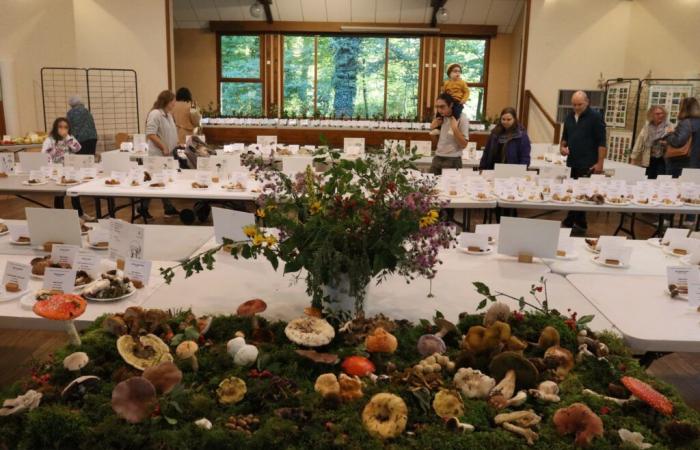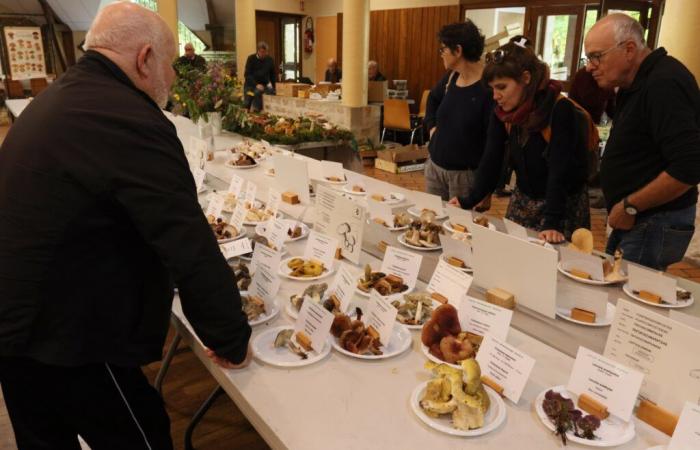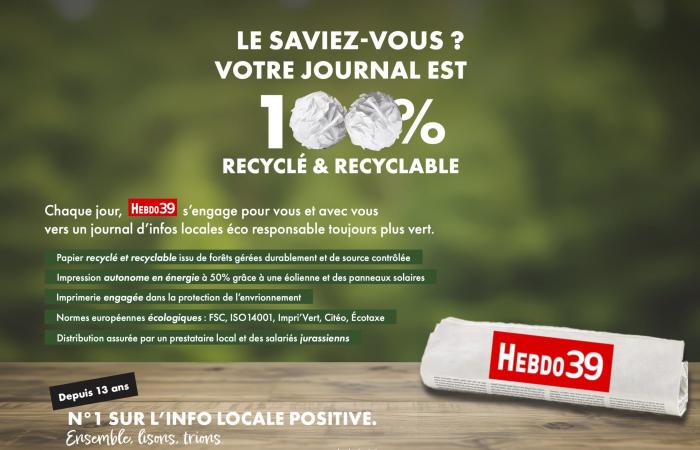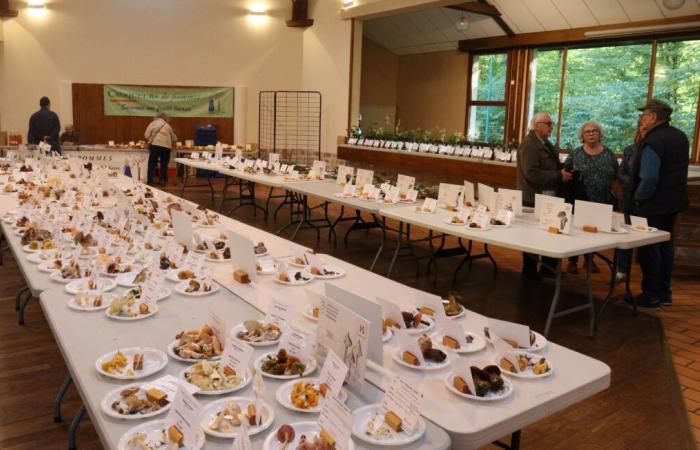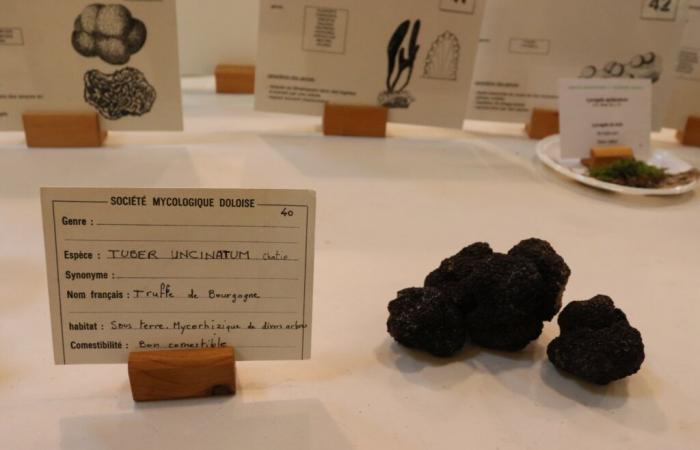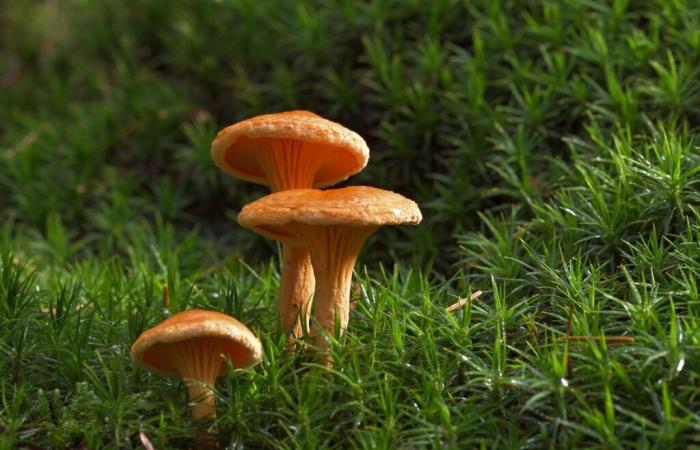There are more than 5,000 species of mushrooms in the Jura!
This leaves room for confusion between russulas, hygrophores, and other homobasidiomycetes… Strange and barbaric names for ordinary “mortals”, compared to the common chanterelles or the eternal rosés-des-prés with which we regularly decorate our omelettes.

Be careful with the apps!
“We must eradicate certain beliefs from the collective imagination, such as thinking that because a slug climbs on a mushroom, it is because it is edible. Likewise, we must avoid relying on mycological applications. Nothing looks more like a mushroom than another specimen from the same family, but sometimes very different! A variety can be recognized above all by its texture and smell. What a smartphone application does not allow” explains Jean-Luc Millet, president of the Doloise Mycological and Botanical Society (SMBD), which organized its traditional annual exhibition last week, in the bucolic Gouvenelle de Goux room.
Mushrooms should be eaten within a day
The opportunity to observe nearly 400 different species, some of which are very similar and yet sometimes have notably different properties!
Even if few are dangerous, you should remain wary of picking them.
And above all, don't forget that mushrooms must be eaten fresh. Always during the day.
Finally, you should know that mushrooms are fantastic cleaners of nature.
They digest dead leaves and recycle water and mineral salts.
A win-win exchange with the trees that make up our forests.
The association meets every Monday evening at 8 p.m. at the Visitation.
If you have any doubts, you can bring your pickings there to have them examined by the dozens of mycology enthusiasts in the association.
Determination outings are also organized on Saturday afternoons.
Contact with the SMBD:
President Jean-Luc Millet: 06 42 41 81 32
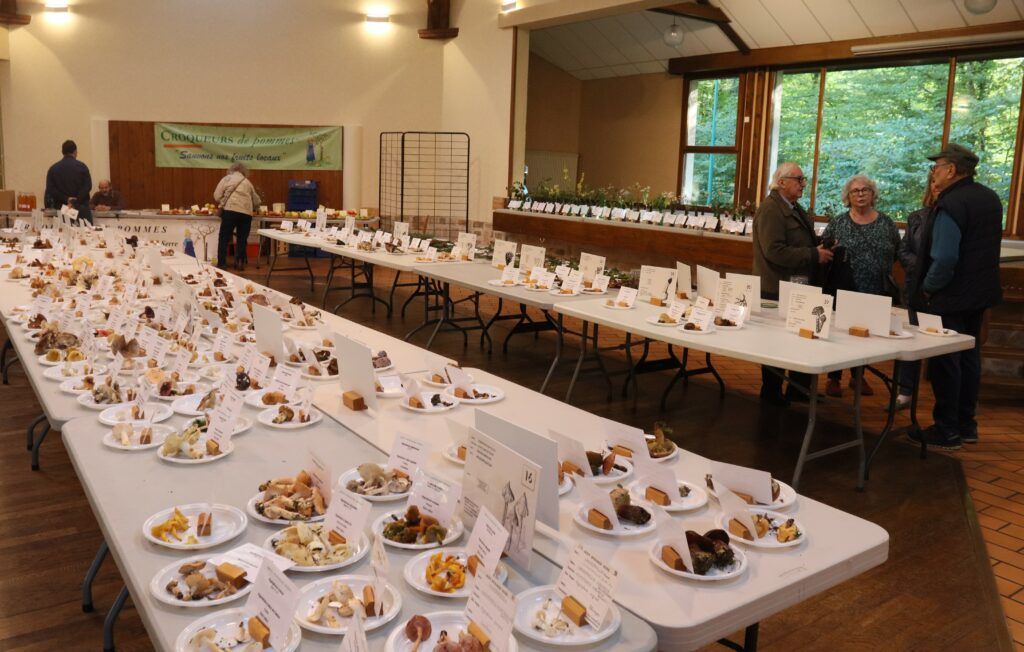
Burgundy Truffle
Its price per kilo is close to 400 euros!
The Burgundy truffle is a luxury product that appreciates the limestone plateaus which dominate the wine-growing coast and the truffle fields made up of wastelands and undergrowth.
At home among hazelnut trees, hornbeams and black pines, this fragile mushroom is harvested from mid-September to the end of January, which explains its very high price.

Amanita phalloides
It is the most famous deadly mushroom… And for good reason, it is alone responsible for 90% of cases of fatal poisoning linked to ingestion, which quite simply makes it the most deadly mushroom in the world.
The amanita phalloides was often used, particularly in the middle of the last century, to get rid of a love rival…
This mushroom has been the subject of much research and many biological active agents have been isolated. The main toxic constituent is alpha-amanitin, which damages the liver and kidneys.
Beyond the initial phase of the pathological process (symptoms only appear between 6 and 24 hours later), there is, to date, no real known antidote.
Phalloid syndrome is the most dangerous, it causes 10% mortality.

Poisoning: more than 1,400 cases recorded each year
In 2023, more than 1,400 mushroom poisonings were reported to Poison Control Centers between July 1 and December 31. They took place mainly in November, while usually the month of October is the most affected.
“The symptoms observed were mainly digestive: abdominal pain, nausea, vomiting, diarrhea. If these poisonings were mostly of low severity, 23 were of high severity but there were no deaths” specifies ANSES, National Agency for Food, Environmental and Occupational Health Safety.
Let's go picking!
Boots on feet, basket in one hand, knife in the other, the picking can begin. Some already know the famous “mushroom corners”, jealously guarded, while others leave a little at random, crossing their fingers to come across a spot of mushrooms or porcini mushrooms. Don't let luck guide your steps and know how to spot the right places.
The chanterelle (called jaunotte) is an excellent edible recognizable by its yellow color and its folds under its cap (be careful, we are not talking about strips!). This mushroom grows from April to October, and sometimes November if conditions permit. It is found mainly in the undergrowth, on moist and acidic soils, and more often at the foot of deciduous trees. However, this does not prevent it from enjoying under conifers. The chanterelle never grows alone! If you see one, look around, there are bound to be others. In addition, this mushroom with its delicate and fine flesh returns to the same place every year: it is the very synonym of the famous mushroom spot!
A very misleading name for an exceptional mushroom
A little later in the season the famous trumpet of death is harvested. A very misleading name for an exceptional mushroom. Also called craterelle or cornucopia, it is very easily distinguished by its black color and its conical shape. Small in size, it does not exceed ten centimeters and is harvested from August to November. It is found in deciduous forests (oak, beech, hornbeam, or even chestnut and hazel trees), especially when the season has been well watered. Generally, trumpet grows in circles or in dense flocks. It is eaten pan-fried, lightly seasoned to fully appreciate all the flavors. To benefit from all its benefits, it is best to enjoy it no more than 48 hours after harvest.
If there were to be a king of mushrooms, for many, it would be the porcini mushroom. And especially the Bordeaux cep, very popular with mycophiles. It can be recognized by its swollen foot when it is young and which becomes cylindrical as it grows. Its flesh is white, non-blue and offers nutty flavors. It has a very pleasant smell. As for the hat, it is adorned with a reddish brown, the sides of which are lighter and highlighted with a white border. It is also found in deciduous forests, but also in coniferous woods and in thickets, and even on forest edges. Autumn 2020 was also very generous with porcini mushrooms of all kinds! It is harvested from September to the first frost.
Incomparable flavors
One of the best known is undoubtedly the country agaric, or meadow rose. It is a kind of large button mushroom, with a much finer and more pronounced taste. White in color, it has slats whose color oscillates between soft pink and old pink. If it turns brown, it is past the age of consumption. Best to leave it there. As its name suggests, the field agaric is harvested in the fields from the first frost of autumn. It can be enjoyed in many ways, including sautéed with a good amount of parsley or in an omelette.
Other lesser-known but equally delectable species cover our Jura woods and undergrowth. If in doubt, always separate the species of mushrooms you harvest and present them to your pharmacist for further analysis. Mushroom poisoning can be dangerous or even fatal. A simple precaution guarantees you a moment of very seasonal indulgence, with the incomparable flavors of autumn.

Do we cut or pick?
Two schools divide mushroom pickers? Should the mushrooms be cut or pulled out to ensure growth the following year? In reality, and according to long-term studies, harvesting mushrooms does not harm their annual regrowth. Whether they are cut or torn off doesn't change anything, obviously. In any case, it would be best to grasp the base of the foot between your thumb and forefinger and turn it gently. Then, plug the hole to protect the remaining mycelium. Some pickers do not hesitate to throw the waste from their harvest into their own garden to see mushrooms growing there the following year.
What does the law say?
The harvest of mushrooms must be done in national forests (belonging to the state) and for family consumption. Collections must not exceed 5 liters per day per person. Furthermore, it is strictly forbidden to pick mushrooms for resale.


